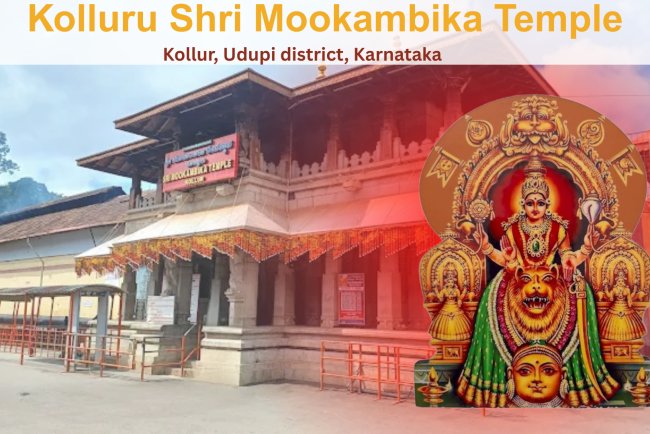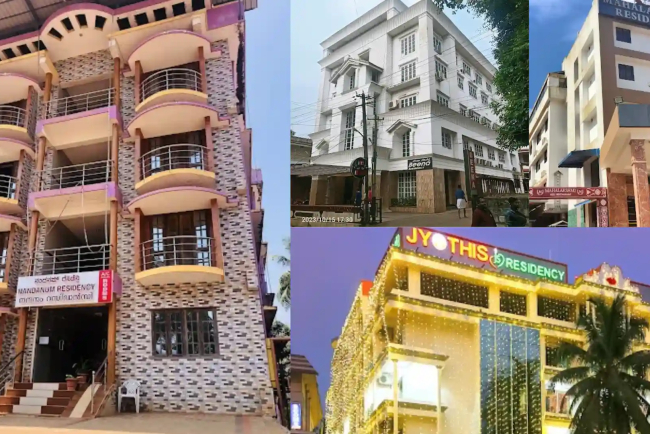Everything You Need to Know About Weather in Kollur Before Your Visit
Get accurate Weather in Kollur climate overview, monthly temperatures, monsoon rainfall, best time to visit, packing tips, and Kollur Mookambika Temple weather insights for smooth darshan.
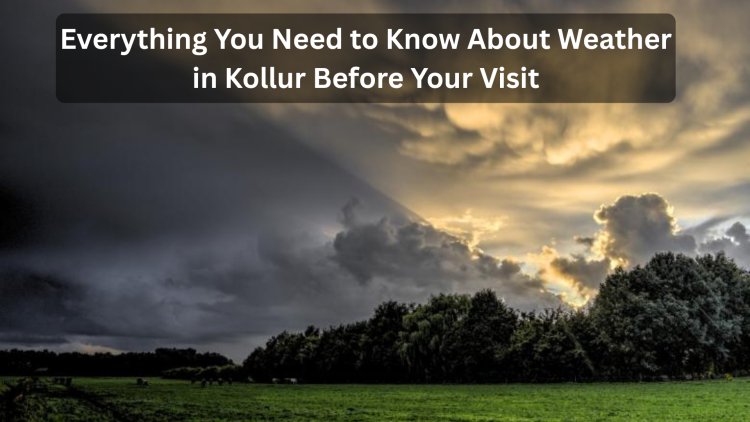
Planning a trip to Kollur? Nestled in the Western Ghats of Udupi, the town is famed for the sacred Mookambika Temple and lush rainforest trails. Understanding the Weather in Kollur helps you time darshan, pick the proper clothing, and plan road travel safely. This guide explains Kollur's climate type, seasonal patterns, and monthly temperatures, with practical packing tips and travel advice. Whether your focus is on Kollur Mookambika Temple weather or treks, you’ll know when to visit for comfort and clarity.
Overview of Kollur Climate
Kollur experiences a tropical monsoon climate, heavily influenced by its geographical position in the Western Ghats. The weather remains humid for most of the year, with significant rainfall between June and September.
Geographical Location and Climate Type
Kollur sits in the Byndoor taluk of Udupi district, Karnataka, at the foothills of the Western Ghats, about 35–40 km inland from the Arabian Sea coast. This setting gives the region a tropical monsoon (Am) climate: warm year-round, very humid, and dominated by seasonal rains. Moisture-laden southwest monsoon winds rise over the Ghats, causing orographic rainfall, which feeds Kollur’s dense evergreen forests, streams, and waterfalls. The same hills moderate temperatures and create quick weather shifts sun to drizzle to fog within hours shaping daily life and Kollur Mookambika Temple weather patterns that pilgrims should plan around.
Average Temperature Range
The temperature in Kollur stays broadly between 20°C and 35°C throughout the year. Summers (March–May) are the warmest, with daytime highs of 32–35°C and sultry evenings around 25–27°C. Pre-monsoon heat can briefly touch 36–38°C on some afternoons. During the southwest monsoon (June–September), cloud cover trims daytime highs to 28–31°C, while nights hover near 23–25°C. Post-monsoon and winter (October–February) bring the most pleasant conditions: days usually 27–30°C, with cooler nights 18–22°C the mildest stretch for temple visits and sightseeing. Overall, expect warm days, gentler nights, and only modest day-night variation thanks to coastal-Ghat influence.
Humidity and Rainfall Patterns
Expect high humidity year-round (70–90%), with the stickiest days in late summer and the monsoon. The Western Ghats wring out moisture from southwest winds, giving Kollur hefty rainfall often 4,000+ mm annually. Showers start as pre-monsoon bursts in May, intensify from June to September, and taper by October. Monsoon days swing between steady rain and sudden cloudbursts with thunder, low clouds, and mist around the temple and forested slopes. Roads can get slick; minor waterlogging and occasional treefall are possible during prolonged spells. Post-monsoon brings clearer skies and gradually lower humidity, while winter mornings can feel calm and dewy. For comfort, plan temple darshan around lighter hours and keep quick-dry clothing and rain gear handy.
Seasonal Weather in Kollur
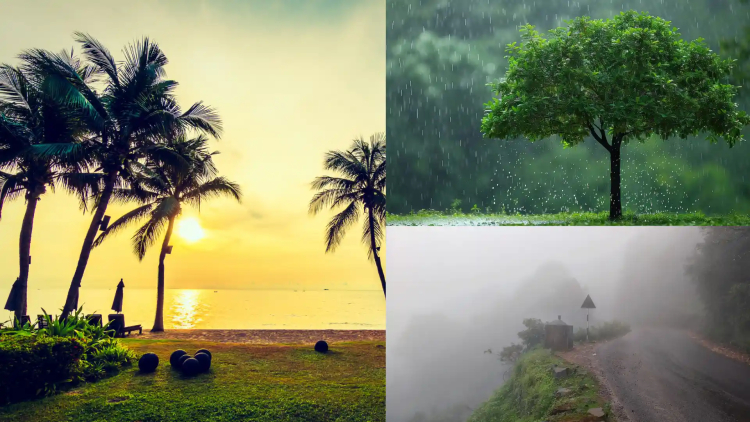
Each season in Kollur shapes your experience from temple queues and darshan comfort to trekking safety and road conditions.
Use this snapshot to time your visit with clarity and ease.
Summer (March–May)
-
Temperature ranges from 28°C–35°C.
-
Afternoons are humid, but mornings and evenings are manageable.
-
Ideal for: Early temple visits and short nature walks.
-
Travel Tip: Carry light cotton clothes, sunscreen, and drink plenty of water.
Monsoon (June–September)
-
Heavy rainfall transforms Kollur into a lush paradise.
-
Rivers and waterfalls swell with beauty, but trekking trails become slippery.
-
Ideal for: Nature lovers and photographers.
-
Caution: Road travel may get delayed; leeches are common on trails.
Post-Monsoon / Autumn (October–November)
-
Weather is clear and refreshing after the rains.
-
Perfect time for temple visits, sightseeing, and family trips.
-
Avg. temp: 20°C–28°C, very comfortable.
Winter (December–February)
-
Temperatures range between 15°C–25°C.
-
Peak tourist season with large pilgrim gatherings.
-
Best for: Kollur Mookambika Temple darshan, trekking, and stress-free travel.
Monthly Weather Guide
|
Month |
Avg. Temp |
Rainfall |
Best Activities |
Dress Code |
|
Jan |
19–29°C |
Low |
Early darshan, town walks |
Light layers, shawl |
|
Feb |
20–30°C |
Low |
Temple visits, short trails |
Cotton + light layer |
|
Mar |
23–33°C |
Low–Mod |
Dawn darshan, shaded walks |
Cotton, hat, sunscreen |
|
Apr |
25–35°C |
Low–Mod |
Early darshan, AC stays |
Light cottons, cap |
|
May |
26–35°C |
Mod |
Morning visits, hydrate |
Quick-dry wear, umbrella |
|
Jun |
24–31°C |
Very High |
Temple focus, waterfalls (with caution) |
Raincoat, waterproof shoes |
|
Jul |
23–30°C |
Very High |
Scenic drives, indoor rest |
Full rain gear |
|
Aug |
23–30°C |
Very High |
Monsoon views, limited trekking |
Waterproofs, spare socks |
|
Sep |
23–31°C |
High |
Post-rain greenery, short walks |
Light rain layer |
|
Oct |
22–30°C |
Mod |
Family trips, sightseeing |
Cotton + light layer |
|
Nov |
21–29°C |
Low–Mod |
Darshan, day trips |
Comfortable cottons |
|
Dec |
19–28°C |
Low |
Peak pilgrimage, clear days |
Light woollens at dawn |
How Weather Affects Your Visit to Kollur
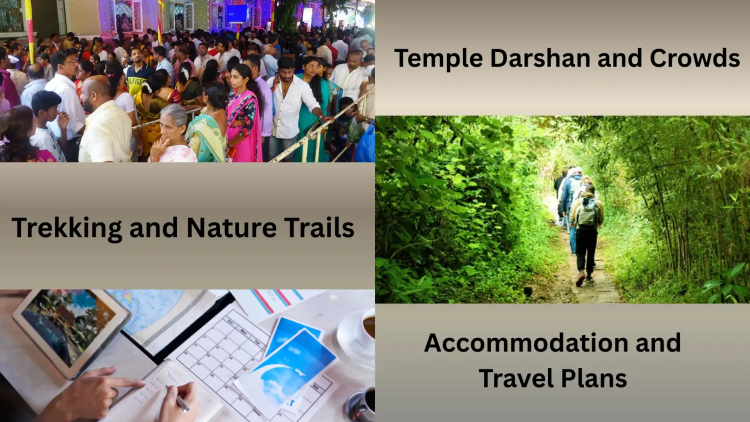
Kollur’s seasons directly shape temple queues, trekking safety, and hotel availability.
Temple Darshan and Crowds
Cool, clear months (Oct–Feb) see peak pilgrims and longer queues; book rooms and plan Kollur Mookambika Temple darshan at dawn. Monsoon rains can thin crowds but cause delays carry rain gear and buffer time.
Trekking and Nature Trails
Best from Oct–Feb: firm trails, good visibility. Monsoon (Jun–Sep) turns paths slippery with leeches and stream crossings; choose short, marked routes or skip trekking on heavy-rain days.
Accommodation and Travel Plans
Winter and festival periods sell out early reserve in advance. In summer, pick AC rooms and hydrate. During monsoon, expect slower roads, occasional outages, and flexible check-ins; keep alternate routes handy.
Packing & Dress Code Tips Based on Weather
Smart packing keeps you comfortable in Kollur’s changing conditions.
Summer Essentials
Light cottons or breathable kurtas, UV hat/cap, sunglasses, SPF 30+, electrolyte sachets, deodorant wipes, sandals plus one closed shoe, and a thin stole/dupatta for temple modesty.
Monsoon Essentials
Full-length raincoat or poncho, compact umbrella, waterproof shoes, anti-leech socks, quick-dry outfits, spare socks in a ziplock, microfiber towel, and a dry bag for phone/documents.
Winter Essentials
Light sweater/shawl for dawn darshan, full-length cottons, closed shoes with grip, moisturiser and lip balm for dewy mornings, and a thin travel blanket for kids/elderly.
Travel Tips for All Seasons
- Best Time to Visit Kollur: October–February for pleasant days, lighter humidity, and clear views ideal for temple routines and family trips.
- Check Weather Before Travel: Monitor the Weather in Kollur 48–24 hours prior; adjust darshan slots and road timings accordingly.
- Safety Tips During Monsoon: Carry full rain gear, avoid swollen streams, watch for leeches, and add 30–60 minutes buffer to any road journey.
- Avoid Night Travel in Rainy Season: Visibility drops; landslip-prone ghats can be risky aim to reach before dusk.
- Family vs Solo Travel: Families should pre-book stays near the temple; solo travellers can choose early-morning darshan and flexible plans.
- Respect Temple Dress Code: Modest, shoulder-knee-covered outfits; keep a shawl/dupatta handy especially during festivals and peak hours.
Conclusion
Kollur’s tropical monsoon climate makes timing essential. October to February offer clear skies and comfortable temperatures for darshan, family trips, and gentle nature walks. March to May is warm and humid plan early visits and stay hydrated. June to September brings heavy rain, misty hills, and slower road travel, but waterfalls thrive. Check the weather in Kollur before you go, pack for the season, and reserve stays in advance to keep temple visits and sightseeing smooth, safe, memorable, and restful.
FAQs
1. What is the best month to visit Kollur?
October to February is ideal. Temperatures are comfortable, humidity is lower, and skies are clearer perfect for darshan, short forest walks, and family trips. Festival weeks can be busy near the Kollur Mookambika Temple, so book rooms early and plan darshan at dawn for shorter queues. If you love greenery with fewer crowds, late September–early October (post-monsoon) is also excellent.
2. How hot does Kollur get in summer?
The temperature in Kollur during summer (March–May) typically ranges from 32 to 35°C by day, with sultry evenings around 25 to 27 27°C. Brief pre-monsoon spikes can touch 36–38°C. Plan temple visits at dawn or after sunset, wear breathable cottons, hydrate, and consider AC stays. Mid-day walks and treks can feel draining due to high humidity choose shaded routes if you must step out.
3. Is Kollur safe to visit during the monsoon?
Yes, with caution. Monsoon (June–September) brings heavy rain, mist, and slick roads. The hills glow green, streams swell, and waterfalls peak, but trails can be slippery with leeches and occasional fallen branches. Keep full rain gear, add buffer time for road travel, and check local advisories. For Darshan, please arrive earlier, as showers can slow down movement around the temple and parking areas.
4. What should I pack for a winter visit to Kollur?
Carry light woollens (shawl/sweater) for cool mornings and evenings, comfortable closed shoes with grip, and modest temple wear. Days are pleasant, so breathable cottons work well. Add moisturiser and lip balm for dewy mornings, a light scarf/dupatta for temple decorum, and a thin travel blanket if you're visiting with kids or the elderly for early-dawn Kollur temple timings.
5. How does the weather affect Darshan at Kollur Temple?
Weather influences crowds, comfort, and queue times. Cool, clear months (Oct–Feb) draw peak pilgrims reach before sunrise for smoother darshan. Summer heat calls for early or late visits and extra hydration. In monsoon, expect rain-induced delays and slick pathways; carry a compact umbrella/poncho and non-slip footwear. Checking the Kollur Mookambika Temple weather a day in advance helps you time entries and avoid rush windows.
What's Your Reaction?








